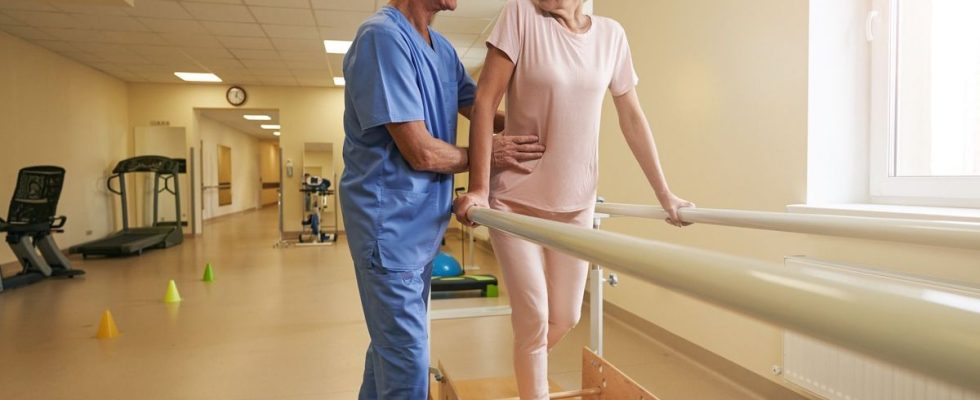Published on
Updated
Reading 3 mins.
Without curative treatment, the management of multiple sclerosis relies primarily on a set of aids to accompany the symptoms of those affected. But the essential role of physiotherapy is not always highlighted. Caroline Peccabin, physiotherapist specializing in multiple sclerosis, tells us about its importance.
Multiple sclerosis is an autoimmune neurological disease that affects around 100,000 people in France. By affecting the myelin, the sheath that envelops each neuron, the disease causes a certain number of symptoms to appear, which are sometimes irreversible and difficult for the patient to live with. Unfortunately, there is no cure yet. Faced with a diagnosis of MS, only treatments to slow the progression of the disease, or to help with rehabilitation are made available. Among them, physiotherapy is of particular importance, not always known, but fully included in the course of care. Caroline Peccabin, physiotherapist specializing in multiple sclerosis, explains this treatment to us.
Caroline Peccabin : In the course of the MS patient, physiotherapy is not a luxury, but one of the branches set up among others, to best help the patient. He is followed by a neurologist whom he sees regularly. When a problem arises in terms of loss of autonomy, an appointment is made with a rehabilitation doctor specializing in rehabilitation care. It is together that they define the help offered according to the contours of the disability, whether it requires full hospitalization or weekly appointments. The proposal evolves according to the analysis of the doctors, the assessments of the teams and the needs of the patient, to find together solutions helping to optimize the patient’s capacity. But in a broader spirit, the physiotherapist intervenes in a multifocal approach to the situation, sometimes with occupational therapy, balneotherapy, educators in physical activity, a neuropsychologist, or even a hypnotherapist to manage the pain.
What can the physio do for the patient?
Caroline Peccabin: These are aids that we put in place to respond to very concrete things that impact the patient on a daily basis. We intervene as soon as it is a question of loss of autonomy, adaptation of technical assistance, loss of walking distance, or other problems such as an aggravation of vesico-sphincter disorders, which is invisible from the outside. but extremely disabling for the patient. On the strength of all our analysis with the various doctors, we propose an adapted program, in terms of exercises, session time, towards a common objective.
Is the response always personalized?
Caroline Peccabin : It is necessarily personalized yes, and this from the first interview which will define the contours of the stay or the needs, taking into account the personalized assessments, during multidisciplinary meetings which even involve the patient’s family to refocus the debate. What we offer must be adapted to his needs, but also meet the patient’s analysis of his own pathology. What sometimes seems trivial, such as help in case of risk of falling, is sometimes very complicated to accept and full of meaning for the patient. These are degenerative pathologies, like a sword of Damocles on the patient’s head. Accepting technical assistance is not always easy.
In prevention, in rehabilitation… When can the physiotherapist intervene?
Caroline Peccabin : MS is an extremely difficult pathology to tackle, because at the level of etiology, science has not yet been able to work out the why and how, but above all because there are as many clinical pictures as there are there are patients. For some, it will evolve over 20 with a relatively moderate impact on walking, for example, while others will end up in a wheelchair after a few years. This is why taking account of the evolution, through imaging and regular appointments between neurologist, attending physician and physiotherapist remains essential, this serves to see how to apply the aids to this particular patient. The physiotherapist also intervenes according to needs: a 70-year-old patient who has no goal of going out may not have the same need for intervention as a 50-year-old patient who plans to continue a social life. and to travel… It really depends on the patient’s age, background and associated pathologies, and life goals. Help can come from the beginning for a problem of risk of falling, or loss of autonomy on walking, as well as much later. It can also be offered and refused, but it is a journey that is hand in hand and that should never be forced.
